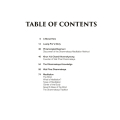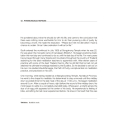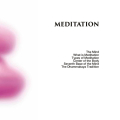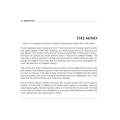body measurements : ค้นหาหนังสือธรรมะ หน้า 26 / 32
หน้าหนังสือทั้งหมด

42
Understanding Life and Rebirth
This Life Next Life
40
While he lives, he is more buoyant, supple, wieldy.
When he is dead, he is weightier, stiffer, unwieldier.
This, Master Kassapa, is evidence for me that there
is neither another
ในบทนี้ ผู้พูดเป็นนายกัสสปะได้อธิบายเกี่ยวกับชีวิตและความตาย โดยใช้การเปรียบเทียบกับลูกบอลเหล็กที่ร้อนและเย็น เพื่อชี้ให้เห็นว่าชีวิตและอารมณ์กระทำเป็นตัวชี้วัดถึงการมีอยู่ของโลกอื่นและผลของการกระทำทั

44
The Nature of Existence and Evidence
18. ' Even though Master Kassapa says this, it still appears to me that not one of those things exists. '
' Have you any further evidence, Prince ? '
' I have, Master Kassapa.'
' What might that be
In this excerpt, Prince engages in a philosophical discussion with Master Kassapa about the existence of the soul. The Prince presents a scenario where a felon is punished severely, questioning the ab

46
Understanding Perception and Existence
He has sight and there are forms, but the organ does not perceive them ; he has hearing and there are sounds, but the organ does not perceive them ; he has smell and there are odours, but the organ do
This text discusses the idea that while humans have sensory organs for sight, sound, smell, taste, and touch, these organs do not necessarily imply the perception of a broader reality. The speaker, Ma

56
There is no visible text to perform OCR on in the provided image. The image mainly features a foggy scene with a body of water, a structure resembling a pavilion, trees, and branches.

66
หลักฐานธรรมภายในคัมภีร์พุทธโบราณ 1 ฉบับวิชาการ
หลักฐานธรรมภายในคัมภีร์พุทธโบราณ 1 ฉบับวิชาการ
1. สอนให้หยุดใจนี้ไว้ที่ศูนย์กลางกายในการปฏิบัติสมาธิภาวนา
2. แสดงความสำคัญของศูนย์กลางกายต่อการเข้าสู่ธรรมาหรือการรู้แจ้งเห็นจริงในธรรม
3. บ่งชี้ถึงควา
เนื้อหาเกี่ยวกับธรรมภายในในคัมภีร์พุทธโบราณ ซึ่งคือการสอนให้หยุดใจไว้ที่ศูนย์กลางกาย, ความสำคัญของศูนย์กลางกายต่อการรู้แจ้งเห็นจริงในธรรม และความสัมพันธ์กับการตรัสรู้ โดยได้อธิบายถึงกายภายในหรือกายแห่

271
คาถาที่ 6 ของบทที่ 16: ธรรมาธูปรวงศ์
(คาถาที่ 6 ของบทที่ 16) ธรรมาธูปรวงศ์ จ ปราณบุรี
ยาส ตานุตตร ยอดธรรมาวุธ สตูป คมภิรึ สรุปธิวิตี้ ฯ ตตรร
จ สตูปมุขเฏียํ สมุน ป(ศยด ศากายมุนี ชิน อิทิ ปรากฏคนตํ มโนช
เณจ สุวรรณ จ) (Thomas 1916d: 114)
ค
บทนี้กล่าวถึงการเข้าสู่ธรรมชาติที่แท้จริงและการเห็นพระพุทธเจ้าในรูปแบบของรูปปั้นทองคำ ซึ่งเป็นการหยุดยั้งความโลภ โกรธ และหลง โดยการสัมผัสประสบการณ์ภายในที่เกิดจากการปฏิบัติทางจิต การบรรยายนี้เกี่ยวข้อ

292
หลักฐานธรรมในคัมภีร์พุทธโบราณ
หลักฐานธรรมภายในคัมภีร์พุทธโบราณ 1 ฉบับวิชาการ
ในพระพุทธศาสนานั้น รูปกาย (physical body) มีบทบาทในฐานะเป็นที่ตั้งของจิต ซึ่งกายหรืออัตภาพของแต่ละคนโดยทั่วไปจะทราบกันดีว่า จะมีขนาดกว้าง 1 ศอก ยาว 1 วา
บทความนี้พิจารณาบทบาทของรูปกายในพระพุทธศาสนา อธิบายว่ากายเป็นที่ตั้งของจิตและประกอบด้วยธาตุสี่ ดังที่พระพุทธเจ้าสอนว่าโลกคือทุกข์และมรรคคือหนทางสู่การดับทุกข์ โดยการกลับเข้าสู่ภายในจะนำไปสู่นิรโธที่แท

85
หลักฐานธรรมภายในคัมภีร์พุทธโบราณ
หลักฐานธรรมภายในคัมภีร์พุทธโบราณ 1 ฉบับรวมงานวิจัยโดยอ 번호
14 สมณะอังอัจังกิว่ากว่า ในสมันที่น่าท้าทายท่านอธิบายว่า ว่าชวาทุกคนในเดียงมัมหาขยาย และเนียน จจะเรียนท่องโลกเหล่านั้นที่สามารถวัดได้ 5 และค
บทความนี้สำรวจหลักฐานธรรมจากคัมภีร์พุทธโบราณที่มีความสำคัญ ทำการวิเคราะห์เกี่ยวกับอักษรตัวเขียนเฉี่ยงที่ใช้ในพื้นที่ Eastern Turkestan โดยการค้นพบของ Sir Aurel Stein และวิจัยโดย ดร.ชนิดา จันทารศรีโศล.

86
การวิเคราะห์พาลีกราฟและคัมภีร์มนต์ในพระพุทธศาสนา
Gilgit-Bamiyan Type I
Sander, Lore. 2000. “Appendix: A brief paleographical analysis of the Braḥmī manuscripts
in volume I.” In J. Braarvig, eds., Buddhist manuscripts vol 1. pp. 285 - 300. Oslo:
บทนี้นำเสนอการวิเคราะห์พาลีกราฟในคัมภีร์ Braḥmī และการศึกษาภาษาไทยของบทพระธรรมที่สำคัญ รวมถึงคำแปลของคำสอนจากพระพุทธเจ้าและปรัชญาเกี่ยวกับธรรมะจากแหล่งที่มาแตกต่างกัน แสดงให้เห็นถึงคุณค่าทางวัฒนธรรมแล

114
การศึกษาแนวทางมหายานในพระพุทธศาสนา
the Great Vehicle : Three Mahāyāna Buddhist Texts. Ann Arbor, Mich. : Collegiate Institute for the Study of Buddhist Literature and Center for South and Southeast Asian Studies, University of Michigan
บทความนี้นำเสนอการศึกษาเกี่ยวกับพระคัมภีร์มหายานสามเล่ม เน้นที่การตีความธรรมชาติของพระพุทธเจ้าและความไม่สามารถที่จะรู้จักธรรมได้ด้วยความรู้สึกทางประสาทสัมผัส นอกจากนี้ยังกล่าวถึงงานวิจัยที่เกี่ยวข้องก

288
การพัฒนาจิตตามแนวทางพุทธศาสนา
พระสกthernากฏุตาย, ดูเจ็บ, ดูแก่, ดูเกิด, ของพระมหากาย เหตุให้เกิดและความดับและเหตุให้ดับ ให้เห็นตามความเป็นจริง ทุกข์, สมุทัย, นิธิโร, มรรค...แล้วศูนย์นั้นกลับเป็นธรรมกายหน้าตัก 15 วาเป็นพระอนาค ทำต่
เนื้อหาพูดถึงแนวทางการเข้าถึงความรู้แจ้งตามหลักพุทธศาสนา ซึ่งมีการกล่าวถึงธรรมกาย พัฒนาการทางจิตใจ การไปสู่การหลุดพ้นจากทุกข์ และความจำเป็นในการเข้าใจความจริงเหล่านี้ด้วยตัวเอง โดยยกตัวอย่างพระอรหันต์

48
Seven Kinds of Offerings to the Sangha
" There are seven kinds of offerings made to the Sangha, Ānanda.
One gives a gift to a Sangha of both [bhikkhus and bhikkhunīs] headed by the Buddha; this is the first kind of offering made to the San
This text outlines the seven kinds of offerings one can make to the Sangha, including gifts to the collective body of monks and nuns, and individual offerings specifying bhikkhus or bhikkhunīs. The fi

92
The Victory of Abandoning: Insights from the Dana Sutta
The Victory of Abandoning
9. Dana Sutta
Those 6 things Then, having exhausted that action, that
power, that status, that sovereignty, he is a returner,
coming back to this world.
7. "-- but with the
The Dana Sutta presents profound insights on the nature of giving and its consequences in the spiritual journey. It describes how the mindset behind acts of generosity can influence their outcomes—whe

19
คำศัพท์ ชุดรู้
health
ร่างกาย
body
ห้องน้ำ
restroom
อาบน้ำ
bath
กระเพาะอาหาร
stomach
น้ำ
water
ยาสีฟัน
toothpaste
สกปรก
dirty

45
นิยายสาร Dhamma TIME ประจำเดือน พฤศจิกายน
นิยายสาร Dhamma TIME ประจำเดือน พฤศจิกายน
บทความภาษาอังกฤษจากคำสอบยาย (จากหนังสือ : "คำสอนยาย")
ทำวิชาชาได้
Super-Advanced Meditation
Because I have the purity of body, mind and speech, I have adher
บทความนี้นำเสนอประสบการณ์ที่เกิดจากการที่คุณยายได้รับการเข้าร่วมโปรแกรมสมาธิขั้นสูงที่วัดปากน้ำ โดยไม่ได้ผ่านขั้นตอนการสอบที่เข้มงวดตามปกติ ซึ่งสะท้อนถึงการมีคุณธรรมและความรักในสมาธิของท่าน เช่น ความบ

14
Exploring the Essence of Dhammakaya Meditation
TABLE OF CONTENTS
6 A Moral Hero
14 Luang Por’s Story
36 Phramongkolthepmuni
Discoverer of the Dhammakaya Meditation Method
46 Khun Yai Chand Khonnokyoong
Founder of Wat Phra Dhammakay
This text provides an overview of the Dhammakaya meditation method, highlighting significant figures such as Luang Por and Khun Yai Chand Khonnokyoong. It elaborates on various aspects of meditation,

46
The Journey of Candasaro Bhikkhu: A Monk's Path to Enlightenment
He pondered about what he should do with his life, and came to the conclusion that there was nothing more worthwhile for him to do than pursuing a life of purity by becoming a monk. He made the resolu
Sodh, later known as Candasaro Bhikkhu, decided to pursue a life of purity by ordaining as a monk at the age of 22. He practiced meditation relentlessly and sought the guidance of esteemed teachers ac

79
MEDITATION
The Mind
What is Meditation
Types of Meditation
Center of the Body
Seventh Base of the Mind
The Dhammakaya Tradition

80
The Nature of the Mind and Meditation
76 MEDITATION
THE MIND
"When I'm in peace the world is in peace. World peace begins with inner peace."
Human beings consist of body and mind. The mind is a form of energy w
มนุษย์ประกอบด้วยร่างกายและจิตใจ จิตเป็นพลังงานที่ควบคุมและส่งสัญญาณไปยังสมอง ช่วยให้เราคิด พูด และกระทำได้ดีหรือไม่ดี จิตและสมองเป็นสองสิ่งที่แตกต่างกัน สมองมีรูปแบบทางกายภาพ ขณะที่จิตใจมีรูปแบบที่ไม่

86
In the Dhammakaya Tradition, the Buddha’s words “He who sees the Dhamma sees the Buddha” are taken literally as seeing one’s inner body of enlightenment which is in the form of a Buddha sitting in med
